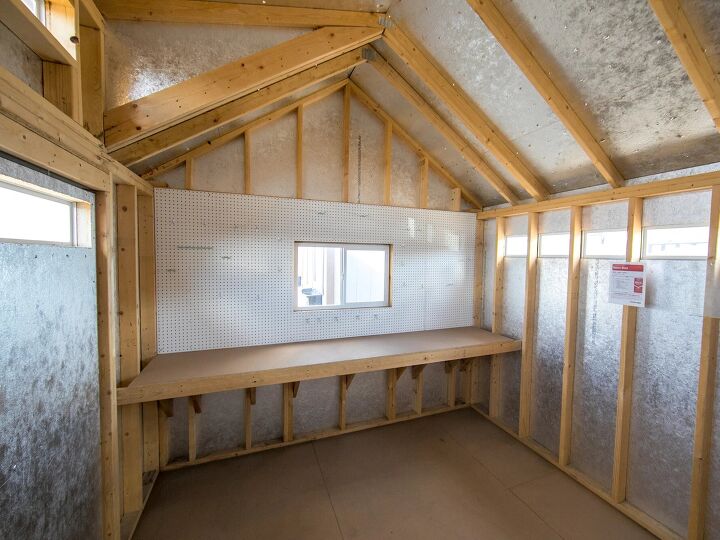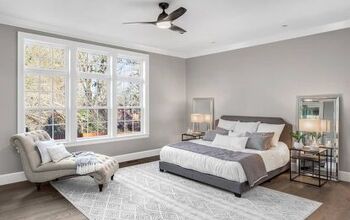Tuff Shed Floor Plans (with Drawings)

Today, sheds have become a lot more than just a place to toss some tools. While many people use sheds for storage, they can also become backyard retreats, playrooms, and even tiny homes. When it comes to Tuff Shed sheds, you’re likely to find them as any one of these and much more.
Tuff Shed has been creating a variety of structures for all sorts of purposes since 1981. Their sheds come in tons of different shapes and sizes, as well as a good-better-best lineup. With endless possibilities for customizations, you can turn a shed into pretty much anything you can think of.
Whether you want a getaway cabin, backyard office space, or convenient storage, a Tuff Shed could be the answer. To start, know what you plan to use it for, then assess your limitations, like size and budget. This is a good starting point for finding the ideal Tuff Shed; you can customize it to fit your plan.
The Main Choices to Consider Before Choosing a Tuff Shed
Think of selecting your shed as picking out a pair of shoes. Before you grab any pair off the shoe rack, you need to have a few critical pieces of information. First, you have to know what you need the shoes for.
For example, are you going to a cocktail party, a beach trip, or need them for working out? Then, of course, what size do you need? What color do you want, and what type of shoe fits you the best?
Depending on the answers to these questions, you select the shoes that fit your needs the best. Likewise, you need to do the same with your shed; consider things like use, size, style, and personal touches.
How Will You Use Your Tuff Shed?
Knowing your shed’s purpose is a vital piece of information when you’re deciding on what exactly you need. For example, will you store tools in it or use it as a gardening hut? Or, do you plan to create a backyard guest suite or a mega-playroom for your kids?
Are you going to move it to a remote location and use it as a fishing or hunting camp? Or, maybe it’s just going to be a simple box where you can store all of your random stuff. No matter what the reason, you need to figure it out before you purchase a Tuff Shed.
Extra Considerations for Your Tuff Shed
Besides guiding your decisions about layouts, styles, and sizes, your shed’s purpose will also determine any extras you need. For example, venting is always a good idea to ensure the best possible lifespan and maintenance for your shed. However, if you plan to be working or living in your Tuff Shed, venting is non-negotiable.
Similarly, you need to decide if you want insulation in your shed. This is because if you plan to insulate or finish off the inside of your shed, it affects the setup. Tuff Shed needs to do certain things to make your shed ready for its future as an insulated building.
Another significant factor is checking with your local building authorities about any necessary permits or inspections. Even if you’re only putting up a small shed in your backyard just for storage, you might need a permit. So, no matter what you’ll be using it for, know your local rules and restrictions.
Where Will You Put Your Tuff Shed?
Another huge factor is where you plan to put your shed. Will it be in your backyard, or do you plan to have it on a separate property? Will it be on grass, dirt, cement, or some other material?
No matter where your shed will go, it’s crucial for the foundation to be level. Typically, Tuff Shed requires the customer to ensure the ground is level before shed setup day.
However, if it’s within four inches level, they’ll handle the leveling at no extra charge. But if the ground is unlevel more than four inches, additional charges will apply. It’s also important the area is clear, and there’s free access to the site for the building materials and supplies.
Choosing Your Tuff Shed Roof Style
Once you’ve taken care of the nitty-gritty, it’s time for the fun part. You get to choose things like style, quality, color, etc.
Tuff Shed offers several roof styles, including ranch, barn, lean-to, and salt-box. Ranch roofs are the more typical house roof style and are very versatile, while barn roofs give you more height. If you plan to put a loft area into your shed, a barn roof is ideal.
If you plan to place your shed next to another structure or below a deck, the lean-to roof’s best. Salt-box roofs offer a unique silhouette and are often used for designs needing a slimmer roofline on one side.
You’ll also find varying heights and sizes within these different roof styles, so make sure you know the specs. Your shed’s size and height are main components that factor into what local building codes allow. It can be difficult to install metal roofing on a shed if you don’t follow the proper steps.
Choosing Your Tuff Shed Series
Tuff Shed also breaks their products down into three series that define the shed’s overall quality and features. These categories are Garden, Premier, and Premier Pro, which is their ”good, better, best” format.
The differences between the various categories are things like roof pitch, shingle type, roof eaves, etc. Of course, one of the most considerable variations is price, always an essential decision in any home improvement project.
Potential Floor Plans for a Tuff Shed
So, once you know your basics as far as purpose, size, location, style, and budget, you can plan your layout. You can get very creative with floor plans for your Tuff Shed. While the retailer or company only offers the basics, with the right knowledge (or contractor), you can do wonders.
Here are a few floor plans you can choose for your Tuff Shed, depending on how you plan to use it.
A Simple Tuff Shed Cabin
This is a sample floor plan of Tuff Shed’s cabin series, a roughly 576 sqft structure with an additional porch. It’s the most budget-friendly unit they offer, and it allows for a kitchen and living area, one bedroom, and one bathroom.
Of course, depending on your needs, you could opt for a more open shared space. For example, you could utilize a futon, sofa bed, or murphy bed to make your living area double as a bedroom. There’s one entry door, and seven windows allow in tons of natural light throughout.
Lofted Barn Shed
If you want to turn your Tuff Shed into a weekend retreat, this roughly 768 lofted design offers ample space. The loft is approximately another 130 sqft and is above the front porch area. This shows the shell of the structure and the placement of the windows, stairs, and doors.
As you can see, you have a nice wide open space to play with for your shared rooms, a bathroom, and a bedroom. The loft could become an extra bedroom, hang-out space, or you could use it for storage.
The Work Shed
If you’re planning on using your Tuff Shed as a workshop, you could go with the bare bones. However, optional features like a built-in workbench and pegboard help make this shed ready for work. You can even use plywood for a shed floor, so the possibilities are endless.
From Tuff Shed to Small Home
Tuff Shed’s two-story Yukon Cabin offers approximately 864 sqft on the lower level with roughly another 375 sqft upstairs. You can choose from various configurations or window and door placement, etc. Then, it’s all about making it your own.
Here, the lower level provides ample shared space for the kitchen and living area. Then two bedrooms with a bathroom in between, finish out the space. Finally, in the loft area, you can design it to suit your needs.
Perhaps you need an extra bedroom and a storage space, maybe even an additional bathroom. Or, you could create a game room space in the entire loft.
Related Questions
How can I make sure the site for my Tuff Shed is level?
To test the levelness of your shed’s future home, you’ll need some wooden stakes, string, and a level. First, place a stake in the ground where each corner of your shed will go. Next, determine which corner is the highest and tie the string around it, laying the line on the ground. Then, stretch the string to the first lower-point stake and attach it loosely. Move it up or down on the stake, using the level to determine its proper position. Once the bubble in your level indicates you’ve found the right point, measure from the ground up to the string. This measurement tells you how off-level this corner is. You can repeat this with the other stakes to assess how much you need to level your site.
How do I properly maintain my Tuff Shed?
Protect your Tuff Shed by ensuring there’s a way for rainwater to flow away from it. Also, ensure the ground stays level. Tuff Shed also recommends not installing rubber or vinyl flooring in the shed as it can cause rotting issues. It’s also a good idea to regularly paint your shed to protect it from the elements. In fact, Tuff Shed’s warranty stipulates owners must repaint their shed every five years.
Are Tuff Sheds weathertight?
Tuff Shed strives always to make their buildings weathertight. However, the structures are not airtight, so air and things like mice and bugs can still get in. Of course, this could also happen with a traditional home. This is why people use things like seals and caulking to take care of gaps, etc.
Related Articles

Stacy Randall is a wife, mother, and freelance writer from NOLA that has always had a love for DIY projects, home organization, and making spaces beautiful. Together with her husband, she has been spending the last several years lovingly renovating her grandparent's former home, making it their own and learning a lot about life along the way.
More by Stacy Randall
































